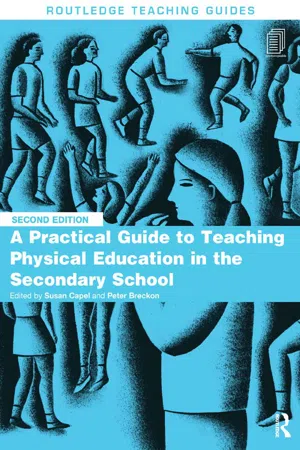
A Practical Guide to Teaching Physical Education in the Secondary School
- 282 pages
- English
- ePUB (mobile friendly)
- Available on iOS & Android
A Practical Guide to Teaching Physical Education in the Secondary School
About this book
A Practical Guide to Teaching Physical Education in the Secondary School is written for all student teachers on university and school-based initial teacher education courses. It offers a wealth of tried and tested strategies together with practical activities and materials to support both your teaching and your pupils' learning. It is designed for you to dip in and out of, to enable you to focus on specific areas of teaching or foci on your course.
This second edition is fully updated with the most recent research and developments in the field and includes brand new chapters. Key topics covered include:
- Understanding your own views about your subject NEW
-
- Lesson planning and schemes of work
-
- Physical Education and Key Skills
-
- Using ICT
-
- Cross-curricular teaching and learning NEW
-
- Safe practice, risk assessment and risk management
-
- Applying theories of learning to your practice
-
- Helping pupils meet intended learning outcomes NEW
-
- Promoting positive behaviour NEW
-
- Overcoming barriers and maximising the achievement of all pupils NEW
-
- Assessing learning
-
- Working with others
-
- Reflective practice and action research.
-
Photocopiable resources offer easy assistance in lesson observation, planning, preparation, delivery and evaluation. An annotated further reading section at the end of each chapter provides advice about selection of the best resources on the web and elsewhere.
Illustrated throughout with examples of existing good practice, this highly practical resource offers valuable support and inspiration to all student teachers as well as those in the early years of their teaching career.
A Practical Guide to Teaching Physical Education in the Secondary School, 2 nd edition is a companion to Learning to Teach Physical Education in the Secondary School, 3rd editio n and can be used to reinforce the basic teaching skills covered in that core textbook. The book can also be used equally successfully on its own.
Frequently asked questions
- Essential is ideal for learners and professionals who enjoy exploring a wide range of subjects. Access the Essential Library with 800,000+ trusted titles and best-sellers across business, personal growth, and the humanities. Includes unlimited reading time and Standard Read Aloud voice.
- Complete: Perfect for advanced learners and researchers needing full, unrestricted access. Unlock 1.4M+ books across hundreds of subjects, including academic and specialized titles. The Complete Plan also includes advanced features like Premium Read Aloud and Research Assistant.
Please note we cannot support devices running on iOS 13 and Android 7 or earlier. Learn more about using the app.
Information
| Part I | Knowing your subject |
| Chapter 1 | The nature of physical education |
INTRODUCTION
AIMS, OBJECTIVES AND LEARNING OUTCOMES
Aims, objectives and learning outcomes
AIMS, VALUE AND JUSTIFICATIONS
Aims, values and justifications
DEFINING TERMS SUCH AS PHYSICAL EDUCATION AND SPORT
Table of contents
- Cover
- Half Title
- Routledge Teaching Guides
- Title Page
- Copyright Page
- Table of Contents
- List of figures
- List of tables
- Notes on contributor
- Series editors' introduction
- Introduction
- Part I Knowing your subject
- Part II Planning for pupil learning
- Part III Teaching for pupil learning
- Part IV Your own professional learning
- References
- Index